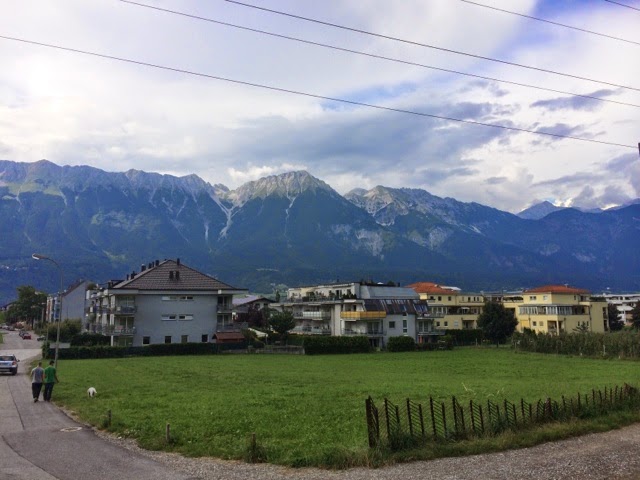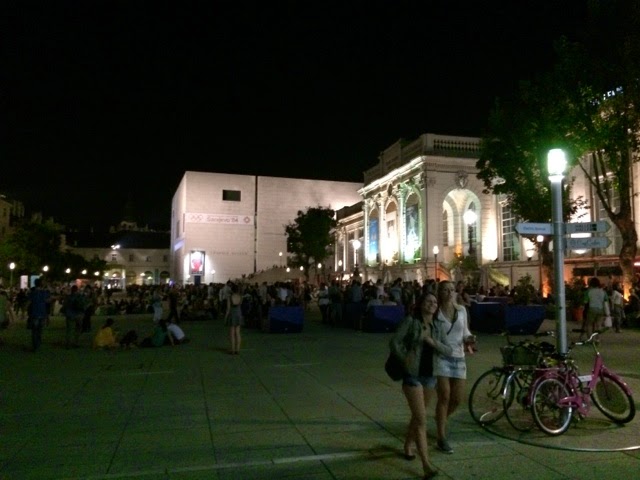I did do that. But not on an empty stomach.
Kebabs, Döners, "Viet Boxes", coffees, kaffees and cappuccinos were all consumed en masse to varying degrees of effect.
I present to you my culinary journey through Europe.
Ireland
Ireland puts up a strong showing. The street kababs in the back alleys of Dublin are some of the best I have ever tasted, although the hefty amounts of Guinness may have contributed to the satisfaction a little. Kebabs here are comparable to Canadian schwarmas, full of sweet sauces, vegetables and savoury chicken in a thin pita. Perfect.
There is a small breakfast sandwich shop on Purnell Street in central Dublin, a tiny walk-in window with green paint trim. Get a breakfast sandwich on white bread. Sliced sausage, cheese and a friend egg. The best things for Guinness-fuelled hangovers ever and an affordable option at only 2.20€.
Coffee was another matter in Ireland. As many know, coffee in Europe is not the drip-style coffee as it is in Canada. Usually a small, strong expresso-type coffee is found. Ireland had something else on the trains featuring "long-life milk" of questionable quality but reassuringly labels itself as "taste like fresh milk". Helps with hangovers so it wasn't too undrinkable:
In Ennis, in western Ireland at the Queens Hotel I had a perfect Irish breakfast; complete with blood sausage, fried egg and a scoop of toast and potato cakes. Nicely done Ireland (sorry no pictures).
France
The reputation proceeds France. A master of the culinary experience, it is a country of artisanal bakeries and pastry chefs.
Stereotypes are often true.
Upon arriving in Rennes, we met Justine, owner of our railway hotel. When asked if we would like the hotel breakfast we waffled and said if we could decide in the morning. Aghast, Justine proceeded to explain she needed to call her baker tonight to get the bread fresh in the morning, she also needed to call the farm she gets her eggs from and her favourite pastry chef for desert. Three people to make one hotel breakfast. The focus on quality is unlike anywhere else.
Dinners were amazing, crêpes at train stations were amazing, coffee was amazing.
Kebabs? Not amazing. For some reason the meat is off and the French inexplicably put French fries in the kebab which turns a complex, savoury delicious bomb into a heavy, dry, deep fried 2,000 calorie mess.
C'est la vie.
Belgium
Waffles. That is all.
Buy them on the street from a stand for 1€ and then go back and buy five more. Sweet and soft, one of the best foods I have eaten from a cart.
Netherlands
A welcome respite during my stay at my friend Sophie's apartment, I are like a regular human for a week. We made traditional pannekoeken - Dutch style pancakes - which are a cross between a thicker fluffier Canadian pancake and a French crêpe. Savoury and delicious.
The main event is cheese. By Canadian standards, cheese is free. Better taste, more choices and 4 to 5 times less expensive on every type of cheese; whether it be the 200 year old artisanal cheese maker shop or the Albert Heilj grocery store, it's simply better and cheaper in every way.
Germany
"Ein Döner bitte." (A Döner please) Is a phrase you should learn. Döners are a bit of a variation off of a donair or pita wrap type street food. Ask for spicy and Weiss (white) sauce.
Berlin Hauptbahnhof Döner:
Perfect. Similar but different in Munich:
Look for all you would expect: frankfurters, weiss sausages and many assortments of sausages and potatoes. Leberkäse, a thick-sliced pork ham sandwich with mustard is popular in Munich. Very good.
Also look for "Viet boxes" in Germany, the saltiest version of Vietnamese food that comes in a box to walk with. I discovered this during an ill-fated seach for Vietnamese pho soup that is so common in Canada.
Viet boxes are closer Canadian Chinese food than what we would call Vietnamese food. My suspicion is that Germany is relatively new to Vietnamese and Asian cuisine so they simplified the menu for German audiences. Disgustingly salty, but will do in a pinch.
Austria
Döner obviously, with a unique Austrian flair. Note the lack of a spicy sauce replaced by chilli flakes and the Weiss sauce on the outer edge of the bun instead of deep inside. Whoever said Austria and Germany are practically the same place? The diversity is outstanding:
Austria redefines coffee and desserts. At Café Mozart at Hotel Sacher in central Vienna I enjoyed a Melanche - a Viennese-style coffee with foamed milk served with a glass of water - and a Sachertorte à la Sacher - the delicious chocolate cake style invented in the Sacher Hotel in the 1800s. Along with he scenic background of marble landmarks and beautiful museums it was a tasty highlight. And by highlight I mean the best dessert I have ever eaten:
Another thing that Vienna offered, begrudgingly I might add, was my Pho soup. After 30 or so days on the road, I finally have a taste of home:
Austria wasn't finished there.
Veal Wiener Schnitzel. Expensive, but a must eat after a 25 kilometre walking day. Filling and savoury ( a trend in Austrian/German cooking I find):
Best of all was a dish called Kalbsbutter schnitzel mit Erdäpfelpüree or veal meatballs with mashed potatoes. Off the charts tasty, so much flavour and spice in the meat. Easily the best dish so far:
Even for myself, eventually even the tastiest of kebabs and Döners gets tiring and I was forced to cook for myself a few days; no easy task in sketchy hostel kitchens where there is a bizarre assortment of equipment and utensils to make a dish with. I did manage a little penne with a homemade garlic and basil red wine tomato sauce complete with sautéed onions and browned green pepper. The whole meal cost 4€, including the bottle of wine.























































